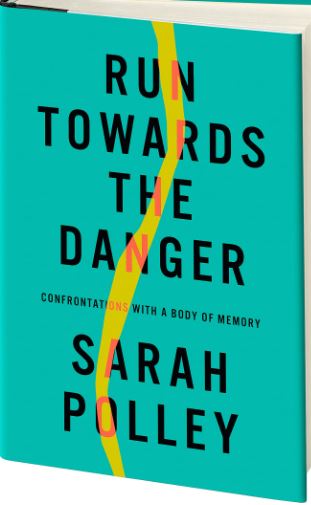I’ve borrowed the title of Sarah Polley’s book for this post. I just finished reading it and give it five stars. It’s not a memoir, exactly. It’s a collection of essays about pivotal times in her life. (It was published last year, before she won the Oscar for Women Talking.)
The stories are surprising and deeply personal. Sarah writes to figure out the meanings of these slices of her life, which include major health issues, an assault she buried in her memory, and head-shaking experiences as a child actor.
I loathe spoilers and I promise you, I’m only going to reveal some details about her book’s final essay. Because it’s had a major impact on me and my seemingly endless search for a fix for chronic neck pain that began with two whiplash-causing car accidents.
Sarah experienced a concussion and endured years of post-concussion syndrome. This involved major migraines, dizziness, sensitivity to sound and light, and so much more. Sarah explained it so well that I now feel I have an understanding of what a friend is going through with a similar condition.
I Am Not A Doctor
Before I continue I must make clear that I don’t claim to suggest any of what I learned from Sarah’s book is necessarily right for anyone else. I am not medically trained. I only know that what I read in Run Towards the Danger shifted the way I view my own pain and changed the way I choose to deal with it.
For years, I visited a wonderful chiropractor. She was the only therapist who gave me any relief from the migraines I’d been experiencing since the accidents. Unfortunately, a fill-in chiropractor I saw over the last holidays made my pain much worse. She was too heavy-handed for my needs and the treatment set me back into frequent migraines and limited my range of motion. I know she meant well. And she may have done me a favour. Because undoing what she did took weeks and it made me rethink the path I’ve been on.
In case you wonder, I had consulted my physician after the second crash. All she could offer me was medication (made me sleepy) and physio (simply hurt). I visited an osteopath but felt it wasn’t helping enough. Massage therapy does help. My friend Laurie told me about cranial sacral therapy (CST). I’d never heard of it but my research showed it was legit, so I went.

Cranial Sacral Therapy
The cranial sacral hands-on technique is so gentle you can hardly believe it. The therapist said his touch is “the weight of a dime”. It was a full hour of gentle manipulation of the tissue at the base of my neck, my shoulders, and my forehead. Incredibly relaxing and quiet. And later, I felt the familiar ache of the muscles involved as one would with a deep tissue massage. But he had barely touched me. My headache was gone and I had full range of motion in my neck.
Later that day, I bent down to get Cuddles’ water bowl and smacked the back of my head on the shelf above me when I stood up. The shelf has been there ever since we moved in so it’s not like I’m unfamiliar with it. I’m just ridiculously accident prone. The headache and neck ache both returned with a vengeance. But I will go back for CST again. Derek thinks I should be wrapped in bubble-wrap afterwards.
Falling for It
I arrived at the last essay in Sarah Polley’s book the day after I took a major fall off our front porch. (If you listen to the Gracefully and Frankly podcast, I apologize in advance for repeating this story!)
I’d been close to falling asleep when I decided to go outside and help Derek with something. I was on the side of the porch when I decided to come down. My sleepy brain told me I was on a step, but I was actually about three times higher. The momentum of stepping off propelled me forward across the driveway onto the concrete floor of the garage. And all I could think was, don’t land on your head! My left side, mostly my wrist, elbow and knee, took the impact as I crashed onto the concrete, stopped by our garbage container. I lay on the floor crying, not sure what I’d injured. It felt like everything. Turns out, it was just about everything. But amazingly, nothing was broken.
As I iced my swollen hand and knee, and sat still that evening, I read the rest of Polley’s book. Sometimes, it’s all about timing.
To deal with her post-concussion symptoms, Sarah had dramatically limited her activity. Makes sense. I’ve done the same with my neck injury. When she’d enter an environment that was overwhelming, she’d retreat. She couldn’t spend much time on the computer or playing with her kids, which was really difficult. Avoiding discomfort is the typical way we’re told to deal with an illness or injury.
Friendly Advice
Then Sarah discovered that a friend with post-concussion syndrome had gotten better, and was out and about, living like she used to. Her friend had seen a concussion specialist in Pittsburgh. Sarah decided to do the same. She traveled to Pittsburgh with a friend where she received an assessment and treatment plan.
This doctor advised Sarah to push herself into those situations that revived her symptoms. To “run towards the danger” instead of retreating, as a way to get her body and mind back to where they were. And after three-and-a-half years of living at, as she wrote, “60% at best” with three little kids, she decided to follow the new plan. Bit by bit, she recovered.
Neck pain isn’t post-concussion syndrome. Not even close. But I thought, what if I apply the same principle to my “condition”? What if, instead of saying, “My head is pounding, I’m going to skip our walk today”, I pushed past the headache and went anyway? What if I reached a little higher, pushed just a little harder, leaned into the discomfort, and waited to see what happened?
This is not to say that either Sarah Polley or I had not been trying to heal ourselves. Or that we are weak or fragile. We were both doing what we were led to believe was the best way forward. But it’s been many years and I don’t feel much farther ahead than when I first got injured. Okay, so maybe yoga (even chair yoga) isn’t in the cards for me. And I probably shouldn’t go canoeing again because the pain after paddling is indescribable. But I can still get up and move around even when it’s the last thing I feel like doing and pain in my body is telling me not to. Instead of taking a Tylenol and diving under the covers, I can push through it and stay active. Maybe running toward the danger will help me, too.
So Far, So Good
I’ve started doing active things when I normally wouldn’t. The day after my fall, there was freezing rain and strong winds. But the next day was beautiful, and despite the pain in my hands, knee, elbow and down both sides of my torso, I went for our regular walk. My headache returned but the sky didn’t fall and the earth didn’t swallow me up. I’m looking at pain differently. There’s no way I’m going to run a marathon or change a tire, but I don’t have to shut down just because it hurts.
It’s early days, but I’m committed to seeing how it goes.
I have no plans to return to the chiropractor. That makes me a bit nervous every time I feel a twinge in my neck or a small ache in my back. But I just think it’s time for something new. Maybe that something new is this. Maybe it isn’t. But it’s damn sure worth a try and I have Sarah Polley to thank for that.


I am glad you got some useful info from Sarah Polley’s book. It boggles my mind that medical professionals, as a group, seem to know so little about chronic pain. It’s so common, you would hope we would have learned more about it by now! So if Polley’s writing helps you, so much the better! Take your knowledge where you can get it! I don’t know about you, but my own experience with my multiple chronic health conditions mirrors my path to embracing stoicism. It’s all one system. (Sorry to go all holistic on you on a Friday!) And as Sarah Polley’s book has helped you, this post you have written will help others. You’re just that awesome.
Sending you strength and positive energy as you embrace this new path towards healing. Well wishes to you, dear Lisa.
Hi Lisa: I read your blog today and thought immediately of a close friend who experienced two separate head injuries in the space of a year. She ran her own brokerage about a twenty minute drive from her home and had to shut it down for many reasons, mainly focusing and extreme pain. Her husband would hold her for hours because she would be crying in pain and she would spend her nights sitting up sleeping in a chair. They were prepared to spend anything to travel to a doctor anywhere in the world and her husband searched the internet for a miracle. I drove her to a doctor in the Markham area for needles in her head but they didn’t help. They read about a doctor in California and another in Europe when they found someone quite local in Barrie. Her first appointment was on a Monday and I could go on in detail about that week, but I will skip to the Friday when she knocked on my door smiling ear to ear — no more pain. That day was preCovid so it has been at least 4 years. I will be pleased to give you her contact info if you would like to speak to her directly. Look up Turner Concussion and Wellness Centre, Barrie on the internet and read where Dr. Roger Turner has trained more than 1000 chiropractors across the world in the Cranial Adjusting Turner Style. Perhaps there is one close to where you live. Maureen
Hi Maureen. Thanks so much for sharing your friend’s story. I’m going to look up this center and the style you mentioned. Much appreciated. You never know and at this point, I’m not going to dismiss any idea except leeches!
Maureen, Dr. Turner passed away last year. His son has taken his place, in case you weren’t aware. Thanks.
Yes, and if you look up his obituary, there are some interesting comments about some miracles he performed. Nice to hear.